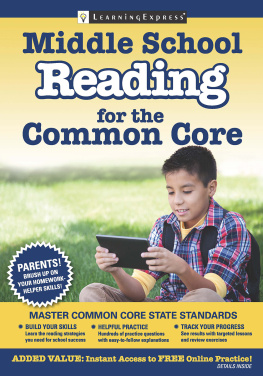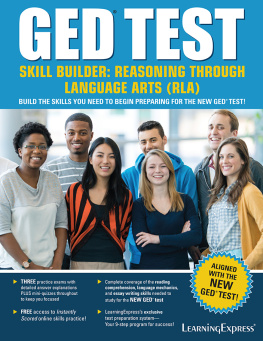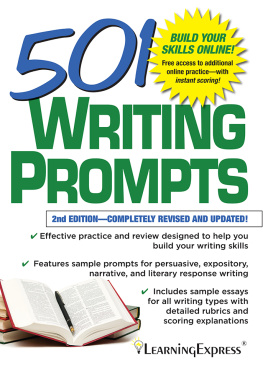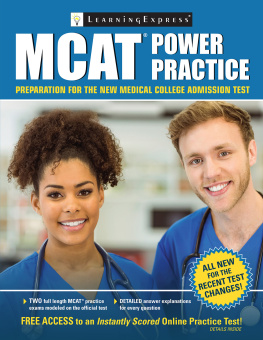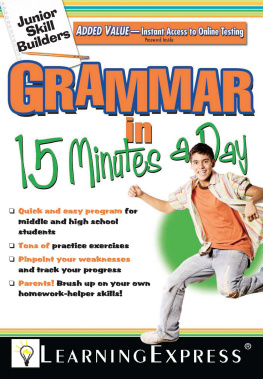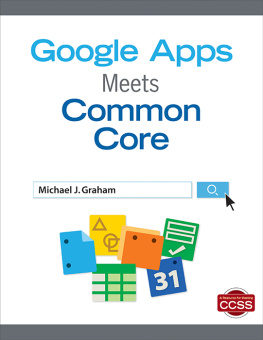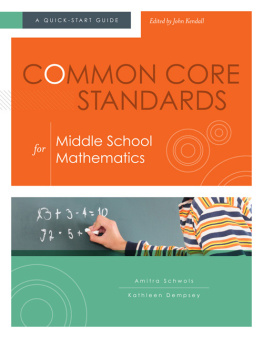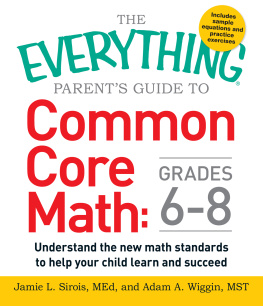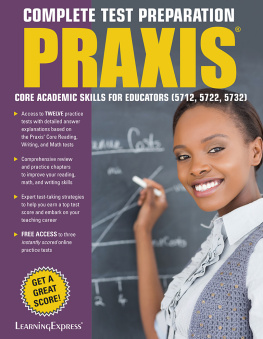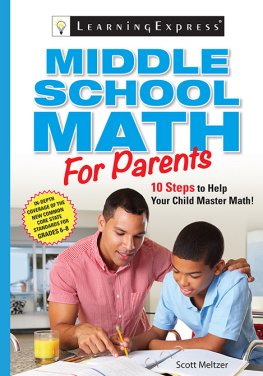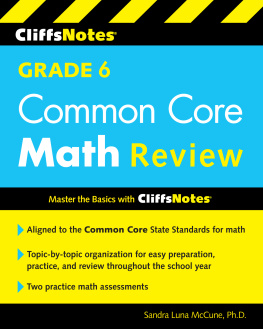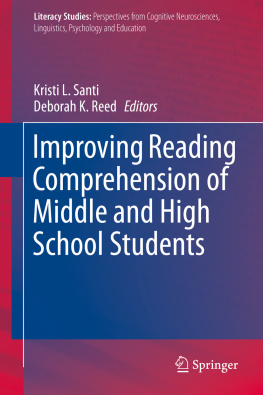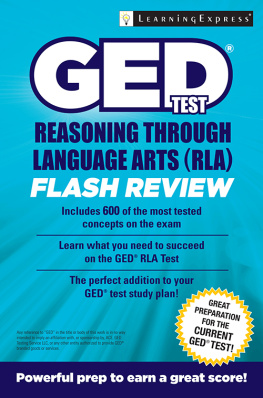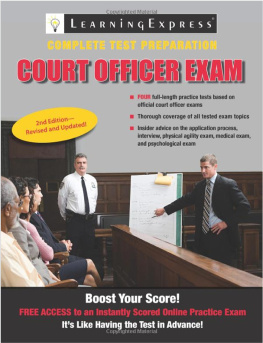LearningExpress - Middle School Reading for the Common Core
Here you can read online LearningExpress - Middle School Reading for the Common Core full text of the book (entire story) in english for free. Download pdf and epub, get meaning, cover and reviews about this ebook. year: 2016, publisher: LearningExpress, LLC, genre: Children. Description of the work, (preface) as well as reviews are available. Best literature library LitArk.com created for fans of good reading and offers a wide selection of genres:
Romance novel
Science fiction
Adventure
Detective
Science
History
Home and family
Prose
Art
Politics
Computer
Non-fiction
Religion
Business
Children
Humor
Choose a favorite category and find really read worthwhile books. Enjoy immersion in the world of imagination, feel the emotions of the characters or learn something new for yourself, make an fascinating discovery.
- Book:Middle School Reading for the Common Core
- Author:
- Publisher:LearningExpress, LLC
- Genre:
- Year:2016
- Rating:5 / 5
- Favourites:Add to favourites
- Your mark:
- 100
- 1
- 2
- 3
- 4
- 5
Middle School Reading for the Common Core: summary, description and annotation
We offer to read an annotation, description, summary or preface (depends on what the author of the book "Middle School Reading for the Common Core" wrote himself). If you haven't found the necessary information about the book — write in the comments, we will try to find it.
Middle School Reading for the Common Core — read online for free the complete book (whole text) full work
Below is the text of the book, divided by pages. System saving the place of the last page read, allows you to conveniently read the book "Middle School Reading for the Common Core" online for free, without having to search again every time where you left off. Put a bookmark, and you can go to the page where you finished reading at any time.
Font size:
Interval:
Bookmark:

Related TitlesMiddle School Algebra for the Common CoreMiddle School Geometry for the Common CoreMiddle School Writing for the Common Core
Copyright 2016 LearningExpress.
All rights reserved under International and Pan American Copyright Conventions. Published in the United States by LearningExpress,
New York. Cataloging-in-Publication Data is on file with the Library of Congress. ISBN 978-1-61103-046-4 Printed in the United States of America 9 8 7 6 5 4 3 2 1 For more information on LearningExpress products, or bulk sales, please write to us at: 224 W. 29th Street 3rd floor New York, NY 10001
He has created leveled readers, test prep guides, and other resources to engage even the most reluctant readers. He studied Print Journalism at Boston University and Elementary Education at Montclair State University. Kahn helped create News-O-Matic, the Daily News Just for Kids. More than a million children have downloaded the app to develop the regular routine of daily reading.
Introduction
Pretest
SECTION 1 BUILD YOUR VOCABULARY
Lesson 1 Homonyms, Homophones, and Homographs Foundational Work for CCSS Reading Standards
Lesson 2 Synonyms and Antonyms Standards RI.68.4 and RL.68.4
Lesson 3 Prefixes and Suffixes Standards RI.68.4 and RL.68.4
Lesson 4 Technical Vocabulary Standards RI.68.4 and RL.68.4
Lesson 5 Context Clues Standards RI.68.4 and RL.68.4
Lesson 6 Denotation and Connotation Standards RI.68.4 and RL.68.4
SECTION 2 VARIETY IN READING
Lesson 7 Literature or Informational Text Foundational Work for CCSS Reading Standards
Lesson 8 Authors Purpose Standards RI.68.6
Lesson 9 The Impact of Word Choice Standards RI.68.4 and RL.68.4
Lesson 10 Text Features and Multimedia Elements Standard RI.6.7
Lesson 11 Comparing Across Media Standards RI.68.7 and RL.68.7
Lesson 12 Comparing Across Texts Standards RI.68.9 and RL.68.9
SECTION 3 ORGANIZATION OF TEXT
Lesson 13 Central Idea and Theme Standards RI.68.2 and RL.68.2
Lesson 14 Chronological Order Standards RI.68.5 and RL.68.5
Lesson 15 Cause and Effect Standard RI.6.5
Lesson 16 Compare and Contrast Standards RI.67.5
Lesson 17 Problem and Solution Standard RI.6.5
Lesson 18 Analyzing Parts of a Text Standards RI.68.5 and RL.67.5
Lesson 19 Evaluating Arguments and Claims Standards RI.68.8
Lesson 20 Making Inferences Standards RI.68.1 and RL.68.1
Lesson 21 Drawing Conclusions Standards RI.68.2 and RL.68.2
Lesson 22 Summarizing Standards RI.68.2 and RL.68.2
SECTION 4 ELEMENTS OF LITERATURE: THE FACTS ABOUT FICTION
Lesson 23 Character and Setting Standards RL.68.3 and RL.8.2
Lesson 24 Plot: Conflict and Resolution Standards RL.68.3 and RL.8.2
Lesson 25 Point of View Standards RL.68.6
Lesson 26 Theme Standards RL.68.2
Lesson 27 Figurative Language: Idiom, Personification, and Hyperbole Standards RL.68.4
Lesson 28 Figurative Language: Similes and Metaphors Standards RL.68.4
Posttest
Glossary
Additional Online Practice
Keep reading to learn the facts about the CCSS.
Getting to Know the Common Core State Standards The fear of change drives much of the misinformation out there, so lets take a closer look at the development, rationale, and goals of the Common Core State Standards.
Much of the backlash against the Common Core State Standards is fueled by misinformation regarding who developed the standards, why they were developed, how they are implemented in schools, and what they mean for your school districts teachers and children.
Who? The idea of having a body of common standards that would cross state lines was introduced by the National Governors Associate Center for Best Practices (NGA), along with the Council of Chief State School Officers. Contrary to what some people believe, the standards were not designed by the federal government, but were instead developed by a diverse group of educators and experts from all around the country. Along with teachers, scholars, assessment developers, and parents, the following well-respected professional organizations helped provide feedback on the standards: National Education Association (NEA) American Federation of Teachers (AFT) National Council of Teachers of Mathematics (NCTM) National Council of Teachers of English (NCTE) The CCSS were developed by well-respected professional organizations along with the help of teachers, scholars, assessment developers, and parents.
Why? The United States educational system has not kept pace with the skills gained by students in many other industrialized countries. Although the U.S. used to rank first for high school graduation, it has slipped to 22nd among the top 27 industrialized countries while college retention rates are also plummeting. For students who successfully make it into the halls of higher education, university educators are noticing that the preparedness levels of incoming students are noticeably declining. The Common Core State Standards aim to raise the bar of the material presented to students in K-12. The CCSS are not only aligned across state lines, but they are also internationally benchmarked to help students gain the skills they need to compete on the global market.
The desired outcome of the CCSS is to give students the applied skills they need for college, work, and life. ________________ ________________
What? The Common Core State Standards are a collection of learning goals that outline the skills students should gain at each grade level. The standards give students and parents a clear understanding of the knowledge needed to be college- and career-ready upon graduating high school. The standards cover skills in mathematics and English language arts/literacy from kindergarten through 12th grade. One of the main aspects of the reading standards is a shift away from a body of skills that is a mile wide and an inch deep. Instead of rapidly moving from one concept to the next, the standards present a more focused set of skills that require students to engage in high level reasoning and problem solving.
The standards are: Based on thorough research and evidence Able to be clearly understood by educators, parents, and students alike In alignment with the expectations of colleges and employers Rigorous in content and require students to apply higher-level reasoning and problem-solving skills A dynamic byproduct of the state standards that have been most effective and a revision of shortfalls in previous state standards Preparing students to succeed in the global workforce through alignment with the educational standards used by top-performing countries The CCSS move away from a curriculum that is a mile wide and an inch deep. Instead of rapidly moving from one concept to the next, the focus is now on to the most essential skills that encourage students to engage in high-level thinking. How? The Common Core State Standards are not to be thought of as a narrow curriculum that cannot be deviated from; the standards are a broad collection of skills that do not include each and every skill students should learn. How school districts and teachers present the standards is determined by how they choose to design their curricula. There are no strict lesson plans to teach from and educators are encouraged to tailor their teaching lessons to best meet the individual needs of their student bodies. When? State education standards were popular by the early 1990s.
Font size:
Interval:
Bookmark:
Similar books «Middle School Reading for the Common Core»
Look at similar books to Middle School Reading for the Common Core. We have selected literature similar in name and meaning in the hope of providing readers with more options to find new, interesting, not yet read works.
Discussion, reviews of the book Middle School Reading for the Common Core and just readers' own opinions. Leave your comments, write what you think about the work, its meaning or the main characters. Specify what exactly you liked and what you didn't like, and why you think so.

